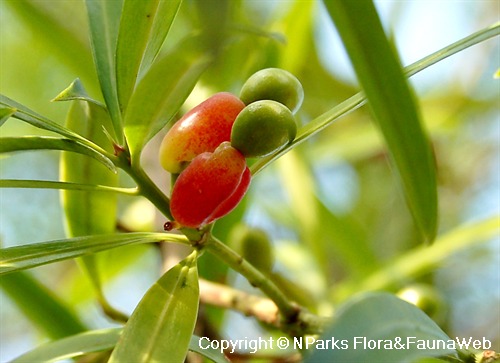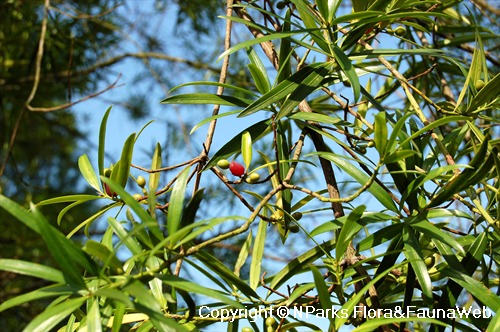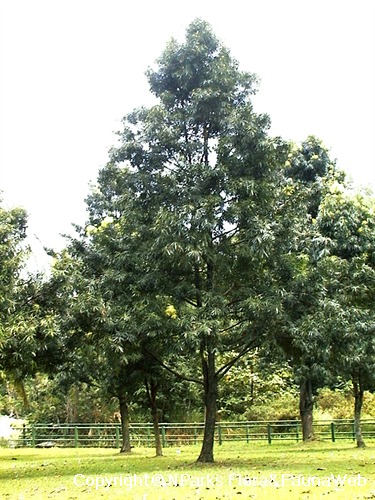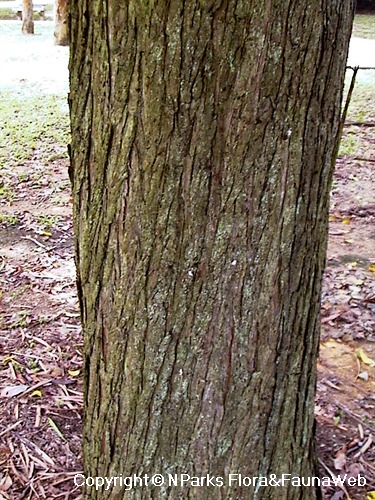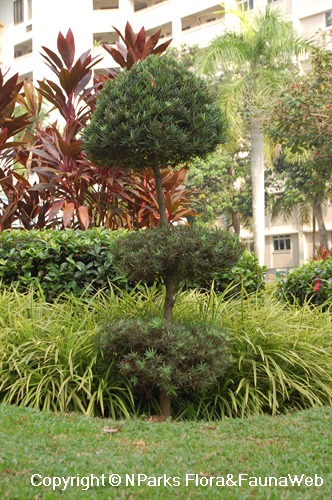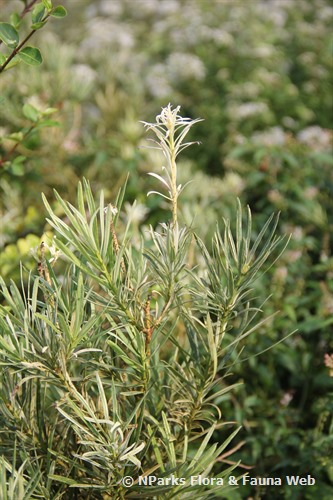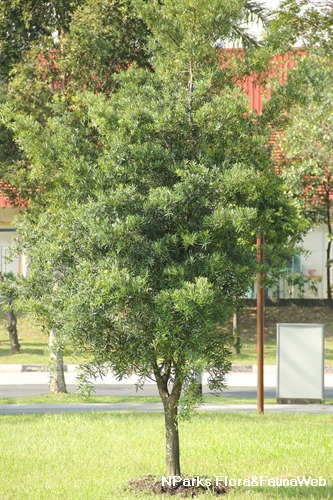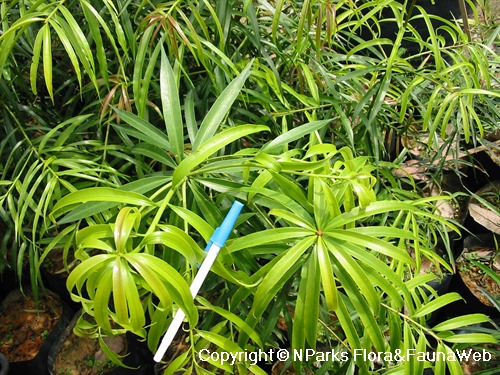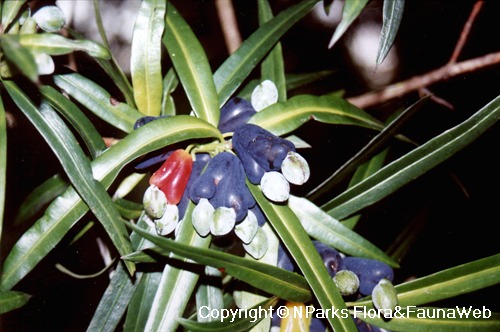
Back
Podocarpus rumphii Blume
| Family Name: | Podocarpaceae |
| Synonyms: | Podocarpus koordersii, Margbensonia rumphii, Podocarpus philippinensis, Nageia rumphii |
| Common Name: | Jati Laut, Kayu China, Sandu, Malakauayan, Mermolas, 海罗汉树 |
Name
Classifications and Characteristics
| Plant Division | Gymnosperms (Non-Flowering Seed Plants) (Conifer) |
|---|---|
| Plant Growth Form | Tree (Medium (16m-30m)) |
| Lifespan (in Singapore) | Perennial |
| Mode of Nutrition | Autotrophic |
| Plant Shape | Conical |
| Maximum Height | 20 m to 30 m |
Biogeography
| Native Distribution | Southern China, Taiwan, Philippines, Peninsular Malaysia, Java, Sulawesi, Papua New Guinea |
|---|---|
| Native Habitat | Terrestrial (Primary Rainforest, Monsoon Forest) |
| Preferred Climate Zone | Tropical, Sub-Tropical / Monsoonal |
| CITES Protection | True |
Description and Ethnobotany
| Others - Plant Morphology | Gymnosperm (non-flowering, seed-producing), coniferous tree, up to 45m height in the wild. Crown is conical for young trees, becoming more oval with age. Leaves linear-lanceolate, pendulous, giving tree a slightly weeping appearance.Dioecious species -- male and female cones found on separate trees. Male cones are pollen-bearing, cylindrical, creamy-white, produced in clusters of up to 8 cones. Female cones are ovule and seed-bearing, solitary, with swollen receptables. Seeds are naked (ie. not enclosed within fruits), green with whitish waxy bloom, resting on top of swollen fleshy receptacles which mature from blue to bright red. Fleshy receptacles edible and reported to be sweet.Slow-growing. Cultivated singly or in groups for neat appearance and minimal leaf litter. Genus name 'Podocarpus' is derived from the Greek words for foot and fruit, a reference to the swollen stalk or receptacle that holds the seed. |
|---|---|
| Ethnobotanical Uses | Food (Herb or Spice): Fleshy receptacles are edible and said to be sweet. (Fruit or Vegetable) Others: Wood considered to be premium softwood timber, used for making houses, canoes, household utensils and carving. |
Landscaping Features
| Desirable Plant Features | Ornamental Fruits |
|---|---|
| Landscape Uses | Suitable for Roadsides, Coastal, General |
Fauna, Pollination and Dispersal
| Pollination Method(s) | Abiotic (Wind) |
|---|---|
| Seed or Spore Dispersal | Biotic (Fauna) (Insects (Ant, Beetle)) |
Plant Care and Propagation
| Light Preference | Full Sun |
|---|---|
| Water Preference | Moderate Water |
| Plant Growth Rate | Slow |
| Rootzone Tolerance | Fertile Loamy Soils, Well-Drained Soils, Waterlogged Soils (Drains Site), Saline Soils / Salt Spray |
| Maintenance Requirements | Moderate |
| Propagation Method | Seed, Stem Cutting |
Foliar
| Foliage Retention | Evergreen |
|---|---|
| Mature Foliage Colour(s) | Green |
| Mature Foliage Texture(s) | Smooth, Glossy / Shiny, Leathery |
| Foliar Type | Simple / Unifoliate |
| Foliar Arrangement Along Stem | Alternate |
| Foliar Shape(s) | Non-Palm Foliage (Lanceolate, Linear) |
| Foliar Venation | Parallel |
| Foliar Margin | Entire |
| Foliar Apex - Tip | Acute, Acuminate |
| Typical Foliar Area | Notophyll ( 20.25cm2 - 45 cm2 ) |
| Leaf Area Index (LAI) for Green Plot Ratio | 3.0 (Tree - Intermediate Canopy) |
Non - Foliar and Storage
| Trunk Type (Non Palm) | Woody |
|---|---|
| Bark Colour(s) | Reddish-brown |
| Mature Bark Texture | Fissured |
| Stem Type & Modification | Woody |
| Root Type | Underground (Tap Root, Fibrous Root) |
Floral (Angiosperm)
| Flower & Plant Sexuality | Unisexual Flowers , Dioecious |
| Flower Colour(s) | Brown, Cream / Off-White, Yellow / Golden |
|---|
| Flowering Habit | Polycarpic |
Fruit, Seed and Spore
| Mature Fruit Colour(s) | Green, Red |
|---|---|
| Fruit Classification | Simple Fruit |
| Fruit Type | Fleshy Fruit , Berry |
Image Repository
Others
| Master ID | 1785 |
|---|---|
| Species ID | 3078 |
| Flora Disclaimer | The information in this website has been compiled from reliable sources, such as reference works on medicinal plants. It is not a substitute for medical advice or treatment and NParks does not purport to provide any medical advice. Readers should always consult his/her physician before using or consuming a plant for medicinal purposes. |


